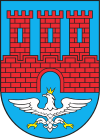 Alternate names: Warta [Pol], Dvart, דווארט [Yid], Varta, Варта [Rus], Liebwart [Ger], Dvurt. 51°42' N, 18°38' E, 36 miles W of Łódź, 24 miles E of Kalisz. 1900 Jewish population: 1,772. JOWBR: Jewish Cemetery. Yizkors: Sefer D'Vart (Tel Aviv, 1974) and Pinkas ha-kehilot; entsiklopediya shel ha-yishuvim le-min hivasdam ve-ad le-aher shoat milhemet ha-olam ha-sheniya: Poland vol. 1: The communities of Lodz and its region (Jerusalem, 1976). This town in Warta gmina, Sieradz powiat, Łódź Voivodeship on the Warta River with 3,392 inhabitants in 2004 had many Jewish inhabitants sent to the Ghettos and eventually to the concentration camps during World War II. Beside the town of Warta, Gmina Warta contains the villages and settlements of Augustynów, Bartochów, Baszków, Borek Lipiński, Chorążka, Cielce, Czartki, Duszniki, Dzierzązna, Gać Warcka, Głaniszew, Glinno, Gołuchy, Góra, Grabinka, Grzybki, Jakubice, Jeziorsko, Józefka, Józefów-Wiktorów, Kamionacz, Kawęczynek, Klonówek, Krąków, Łabędzie, Lasek, Lipiny, Małków, Maszew, Miedze, Miedźno, Mikołajewice, Mogilno, Nobela, Ostrów Warcki, Pierzchnia Góra, Piotrowice, Proboszczowice, Raczków, Raszelki, Rossoszyca, Rożdżały, Socha, Tądów Dolny, Tądów Górny, Tomisławice, Ustków, Witów, Włyń, Wola Miłkowska, Wola Zadąbrowska, Zadąbrów-Rudunek, Zadąbrów-Wiatraki, Zagajew, Zakrzew, Zaspy and Zielęcin. [July 2009]
Alternate names: Warta [Pol], Dvart, דווארט [Yid], Varta, Варта [Rus], Liebwart [Ger], Dvurt. 51°42' N, 18°38' E, 36 miles W of Łódź, 24 miles E of Kalisz. 1900 Jewish population: 1,772. JOWBR: Jewish Cemetery. Yizkors: Sefer D'Vart (Tel Aviv, 1974) and Pinkas ha-kehilot; entsiklopediya shel ha-yishuvim le-min hivasdam ve-ad le-aher shoat milhemet ha-olam ha-sheniya: Poland vol. 1: The communities of Lodz and its region (Jerusalem, 1976). This town in Warta gmina, Sieradz powiat, Łódź Voivodeship on the Warta River with 3,392 inhabitants in 2004 had many Jewish inhabitants sent to the Ghettos and eventually to the concentration camps during World War II. Beside the town of Warta, Gmina Warta contains the villages and settlements of Augustynów, Bartochów, Baszków, Borek Lipiński, Chorążka, Cielce, Czartki, Duszniki, Dzierzązna, Gać Warcka, Głaniszew, Glinno, Gołuchy, Góra, Grabinka, Grzybki, Jakubice, Jeziorsko, Józefka, Józefów-Wiktorów, Kamionacz, Kawęczynek, Klonówek, Krąków, Łabędzie, Lasek, Lipiny, Małków, Maszew, Miedze, Miedźno, Mikołajewice, Mogilno, Nobela, Ostrów Warcki, Pierzchnia Góra, Piotrowice, Proboszczowice, Raczków, Raszelki, Rossoszyca, Rożdżały, Socha, Tądów Dolny, Tądów Górny, Tomisławice, Ustków, Witów, Włyń, Wola Miłkowska, Wola Zadąbrowska, Zadąbrów-Rudunek, Zadąbrów-Wiatraki, Zagajew, Zakrzew, Zaspy and Zielęcin. [July 2009]
WARTA I: US Commission No. POCE00675
The town is located in Sieradz region at 51º42 18º38, 15 km from Sieradz. Cemetery: between Deczynskiego and Sadowa Street. Present town population is 5,000- 25,000 with no Jews.
- Local: Urzad Miasti I Giminy, Rynek 1, 98-290 Warta; tel. 7-40-01.
- Regional: Wojewodzki Konserwator Zabytkow, ul. Kosciuski 3, 98-200 Sieradz, tel. 849- 3815.
- Interested: Urzad Wojewodzki w Sieradzy, Pal Wojewodzki 3, 98-200 Sieradz, tel. 849-71666. Zydowski Instytut Historyczny w Polsce, ul. Tlomackie 315, 00-090 Warszawa; tel. 17-92-20 (or 21).
The earliest known Jewish community dates from about 1554. 1921 Jewish population was 2,025 (49.3%.) The landmarked Jewish cemetery was established about 1554 with last known Conservative Jewish burial 14 Apr. 1942. The isolated suburban flat land has no sign or marker. Reached by turning directly off a public road, access is open to all with a broken masonry wall and no gate. The pre- and post-WWII cemetery size is 2.0 ha. 100-500 stones, none in original location and 25-50% broken or toppled, date from 1825. The 19th and 20th century granite and limestone flat-shaped stones, finely smoothed and inscribed stones, or flat stones with carved relief decoration have Hebrew, Yiddish, and/or Polish inscriptions. Some ahve traces of painting on their surfaces. The cemetery contains special memorial markers to Holocaust victims and known, unmarked mass graves. The municipality owns the property used only as a Jewish cemetery. Adjacent property is agricultural and residential. Occasionally, organized Jewish groups, individual tours, local residents, and private visitors stop. It was vandalized during World War II but not in the last ten years. Care was re-erection of stones by individuals or groups of non-Jewish origin and municipal authorities. Cemetery care now is unpaid occasional clearing or cleaning by individuals and/or authorities. Within the limits of the cemetery are no structures. Vandalism and security are moderate threats. Vegetation and incompatible nearby development are slight threats.
Adam Penkalla, deceased, completed survey and visited site in November 1992 using private documentation.
WARTA II: US Commission No. POCE0000676 Cemetery: 7 Gorna Street. The landmarked cemetery, open with no caretaker, was established about 1554 with last known Jewish burial 14 April 1942. The isolated urban flat land with a plaque in Polish mentioning the Holocaust OR has no sign or marker. [sic] Reached by turning directly off a public road, access is open to all with no wall, fence, or gate. No stones are visible. The cemetery contains special memorial markers to Holocaust victims and no known mass graves. The municipality owns the property used for residential purposes. Adjacent property is residential. The size is reduced by a housing development. Occasionally, organized Jewish groups, individual tours, local residents, and private visitors stop. It was vandalized during World War II but not in the last ten years with no care or maintenance. Within the limits of the cemetery are no structures except the housing development. No threats.
Adam Penkalla, deceased, completed survey in November 1992 using private documentation. He visited the site.
http://www.zchor.org/warta/warta.htm : The Jewish Cemetery of Warta, Ireneusz Slipek, Ada Holtzman's website from extracts from an article Detroit Free Press 4/7/98 by Lori Montgomery and photo. [September 2000]
